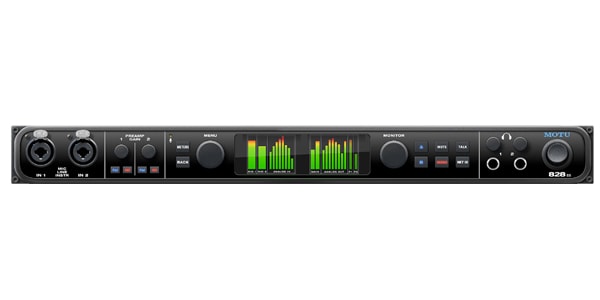
Having now reviewed two MOTU AVB interfaces, I’ve spent a lot of time working within this interface, and it still has the capability to bewilder me on a fairly regular basis! The flip side of this is that it is also complex, perhaps intimidatingly so to some, and that the browser-based interface can be slow to respond, especially when switching between different panes (admittedly, my MacBook is now several years old, and MOTU say things are better on newer machines). In short, this digital mixer is amazingly comprehensive, and from a functional point of view, is every bit as powerful as many dedicated hardware mixers. Rather than describe the workings of this mixer in detail here, then, I’ll refer readers to our review of the 1248 in SOS August 2016.

Internally, all of these interfaces seem to be identical, so like the 1248, the 828es contains a hugely powerful digital mixer with up to 48 inputs and comprehensive mixing, routing and signal processing facilities. So whereas previous 828s have shipped with a control-panel utility called CueMix, the 828es’s internal DSP is controlled from a Web browser, in the same way as on other MOTU AVB interfaces such as the 1248, 8M, 16A and so on. For, as well as being heir to the 828 heritage, the 828es is also part of MOTU’s AVB range, meaning that it can form part of an IEEE 802.1 AVB/TSN networked audio system. (Alas, though, there is but one cable included, and it’s not a Thunderbolt cable.)Ĭompared with the 828x, in fact, the only socket that the 828es has gained is an RJ45, but this is a small clue to the fact that things are completely different beneath the hood. And, like the 828x, the 828es also sports word clock and linear timecode in and out, and can connect to a host computer either over Thunderbolt or USB.
MOTU 828 ES PLUS
There are also two pairs of optical sockets offering up to 16 channels of ADAT-format digital I/O, with the first pair alternatively supporting TOSlink stereo, plus dedicated coaxial S/PDIF I/O and MIDI in and out. Unusually, both mic inputs have dedicated insert points on quarter-inch jacks, allowing hardware processors to be patched into a recording chain. In terms of analogue I/O, it has two ‘combi’ mic/line sockets plus a further eight line inputs on quarter-inch jacks, and its stereo XLR main outputs are joined by eight additional quarter-inch sockets and two headphone jacks. Still housed in a black 1U rackmounting case, this latest and greatest 828 caters to the same market sector as previous holders of that illustrious name, but under the bonnet, it’s bang up to date. Their latest dependable hatchback of the project-studio world is the 828es. As FireWire began to fall out of favour, the MkIII added a USB socket along with sundry other improvements, before the 828x phased out FireWire altogether in favour of Thunderbolt. In 2003, MOTU followed this up with a MkII version, offering better metering, support for high sample rates and additional MIDI I/O. The original 828 was the very first FireWire audio interface, and proved enormously successful, thanks to its well-judged blend of analogue and digital I/O. Likewise, MOTU have had a product named the 828 in their range for no fewer than 17 years, but the world of audio interfaces moves fast, and we are now on the fifth generation.

Today’s Volkswagen Golf doesn’t have much in common mechanically with its 1974 ancestor, but it occupies the same position in the automobile market, and benefits from four decades of accumulated brand recognition. In many walks of life, manufacturers will use the same name to refer to successive generations of products.
MOTU 828 ES SERIES
MOTU’s 828 series has been a valuable studio workhorse for nearly two decades, and the latest is the best one yet.


 0 kommentar(er)
0 kommentar(er)
